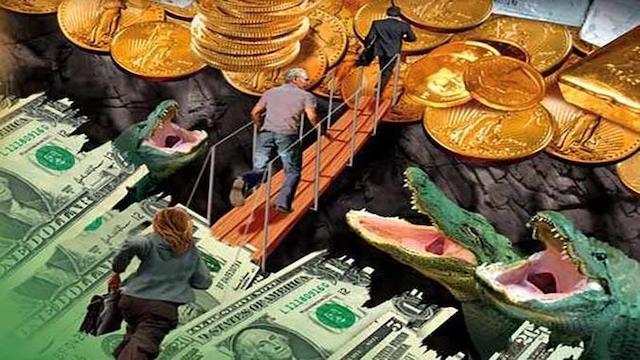“Rising inflation pressures in a low interest rate environment tell a very good story for gold prices in 2021,”

For many market players, 2020 will go down in the history books as the year of unprecedented stimulus measures.
According to the International Monetary Fund (IMF), $12 trillion has been pumped into global financial markets as governments and central banks worldwide have tried to stabilize the economy that was devastated by the COVID-19 pandemic.
Simultaneously, the Federal Reserve, which has led the way in central bank stimulus, has seen its balance sheet balloon to record highs above $7 trillion.
If 2020 saw historic monetary and fiscal stimulus, analysts, economists, and investors are now wondering what the fallout will be, with many expecting to see higher inflation, especially as economic activity picks up in the second half of the year.
In its 2021 outlook published in October, the IMF said that it sees the global economy expanding by 5.2%. According to the projections, the U.S. economy is expected to grow by 3.2%, and the European Union is expected to grow by 5.2%.
Although the IMF sees inflation pressures remaining low, the analysts noted a lot of uncertainty in their forecasts.
“Price pressures could increase, for example, due to the release of pent-up demand as consumers increase spending on items that they had been forced to delay consuming because of lockdowns and restrictions on movement. They could also increase due to higher production costs from persistent supply disruptions,” the IMF said in its report.
The IMF also noted that government fiscal policies and central bank monetary policies could also quickly push inflation pressures out of control.
“The credibility of monetary policy frameworks can also affect price developments. Credibility can suffer where central banks are regarded as conducting monetary policy to keep government borrowing costs low rather than to ensure price stability (“fiscal dominance”),” the analysts said. “In those contexts, inflation expectations can increase very quickly once governments begin running large fiscal deficits.”
According to the Federal Reserve’s latest economic projections, core inflation is expected to rise by 1.8% in 2021, rising to 1.9% in 2022, and rise to 2% by 2023. However, the central bank’s inflation estimate has less impact as it now targets average inflation of around 2%.
Although global markets are awash in historic amounts of liquidity, many economists note that it will not significantly impact consumer price pressure. Many economists expected a sufficient slack in the global economy caused by the COVID-19 pandemic to keep consumer inflation pressures under control.
“Inflation pressures are unlikely to play any meaningful role for some time, which should keep monetary accommodation firmly in place. This bodes well for a continuing recovery of activity once the pandemic is under control,” said economists at Barclays Capital in its 2021 outlook report.
Bank of American is also not expecting to see significant inflation pressures.
“Most countries are running big budget deficits. But fiscal expansion is filling holes in the global economy, not triggering tight capacity and inflationary pressure,” the analysts said in their 2021 outlook report.
“Of course, serious inflation is possible if policymakers do not reverse course as the economy hits full employment. However, that is unlikely until 2022 or perhaps much later. Don’t hold your breath,” they added.
However, many market analysts note that just because inflation isn’t expected to show up in consumer prices doesn’t mean that markets and investors won’t feel inflationary pressure.
In a recent interview with Kitco News, Bernard Dahdah, precious metals analyst at Natixis, noted that instead of driving consumer prices, the excess liquidity is going into capital markets, driving equity valuations to record highs and inflating real estate values.
He added that these inflation pressures are still bullish for gold. The precious metal has become an important diversifier and hedge against overvalued markets.
Chantelle Schieven, head of research for Murenbeeld & Co, said in an interview with Kitco News that her economic base case for 2021 is for muted inflation; however, she added that there is still a lot of uncertainty in financial markets, and it would take much to drive inflation higher.
“There is a lot of money supply in the market, but there is a lack of velocity, which is needed to drive inflation,” she said. “To get velocity, you need people to go out and spend. Even with more stimulus, we don’t see consumers’ spending habits change.”
While inflation is expected to remain subdued, many analysts say that it won’t take much to drive gold prices above the 2020 all-time highs.
The Federal Reserve is expected to leave interest rates at the zero-bound range through 2023. Currently, real interest rates are hovering around negative 48 basis points. Heading into the new year, the value of global debt with negative yields rose to a record $18 trillion.
“The amount of negative debt out there is massive. $18 trillion is a disgusting number,” said Steve Dunn, head of exchange-traded products at Aberdeen Standard Investments.
Dunn added that bond yields are expected to go even deeper into negative territory as inflation picks up. He added that in this environment, gold is becoming more attractive as a safe-haven asset.
“Rising inflation pressures in a low interest rate environment tell a very good story for gold prices in 2021,” he said.
Written by Neils Christensen for Kitco ~ January 7, 2021








